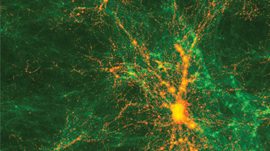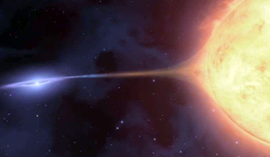Researchers from University of Amsterdam and Northwestern University used the GPU-accelerated Blue Waters supercomputer to produce the first ever simulation to demonstrate that relativistic jets follow along with the precession of the tilted accretion disk around the black hole.
“Understanding how rotating black holes drag the space-time around them and how this process affects what we see through the telescopes remains a crucial, difficult-to-crack puzzle,” said Alexander Tchekhovskoy, assistant professor of physics and astronomy at Northwestern’s Weinberg College of Arts and Sciences. “Fortunately, the breakthroughs in code development and leaps in supercomputer architecture are bringing us ever closer to finding the answers.”
Using the team’s new massively parallel Tesla GPU-accelerated 3D code H-AMR, they performed 3D general relativistic magnetohydrodynamic simulations of tilted thick accretion discs around rapidly spinning black holes, at the highest resolution to date. H-AMR is parallelised via MPI with domain decomposition and scales well to thousands of GPUs, achieving weak scaling efficiency of 85% on 4,096 GPUs for a tile size of up to a billion computational cells on the Blue Waters supercomputer.
The behavior from the simulation aligns with Albert Einstein’s predictions about extreme gravity near rotating black holes, published in his famous theory of general relativity. The jets emitted by black holes are easier to study than the black holes themselves because the jets are so large. This study enables astronomers to understand how quickly the jet direction is changing, which reveals information about the black hole spin as well as the orientation and size of the rotating disk and other difficult-to-measure properties of black hole accretion.
“The high resolution allowed us, for the first time, to ensure that small-scale turbulent disk motions are accurately captured in our models,” Tchekhovskoy said. “To our surprise, these motions turned out to be so strong that they caused the disk to fatten up and the disk precession to stop. This suggests that precession can come about in bursts.”
Read more >
Supercomputer Helps Provide Insight Into Mysterious Black Hole Relativistic Jets
Jan 16, 2018
Discuss (0)










